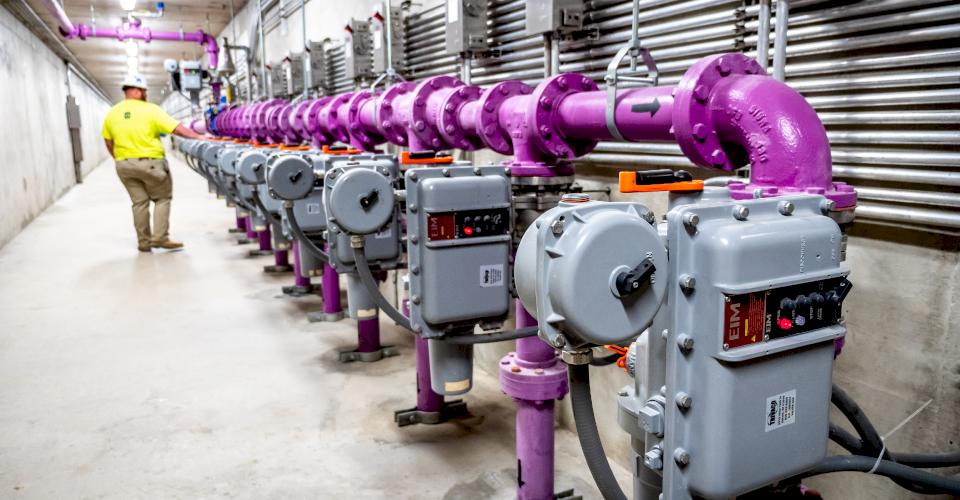The pervasive effect the COVID-19 pandemic has had on all facets of life will go down as one of the most notable events in our world history. In discussions with both large and small utilities, this article is meant to capture water utility managers’ perspectives during the onset of the pandemic, their present status, and thoughts about the future.
Significant Unanticipated Expenses
The financial impact of COVID-19 on drinking water utilities in the United States, as determined by the American Water Works Association in an April 2020 report, will likely be $13.9 billion, a 16.9 percent financial increase on the drinking water sector. These numbers will likely be refined during the second year of the pandemic. Although the sector saw an increase in residential revenues because of stay-at-home policies, this was far overshadowed in decreased revenues in such areas as:
- non-shut offs
- increased delinquencies
- reduced commercial revenues
- increased personnel expenses
- reduced system development charges
- deferral of needed rate increases
- lower customer growth
Because of these financial impacts, drinking water utilities across the country anticipate delaying or reducing capital expenditures by as much as $5 billion (annualized) to help manage cash flows through the crisis. More specifically to smaller utilities, the National Rural Water Association estimated small water and wastewater systems lost $998 million in revenue by mid-July 2020, with these revenues not having the anticipation of recovery.
Were We Prepared?
So, were drinking water utilities prepared for this pandemic? My water utility business experience has seen that water utilities have strategies for a multitude of crises, including terrorism, drought, water quality degradation, operational outages, labor disputes, etc. However, even though utilities often implemented procedures ahead of state guidelines in these scenarios, the pandemic led them to uncharted territory wherein the utility transitioned with all of society.
While utilities consider the safety of the drinking water they provide first and foremost, they also had to manage mask-wearing, social distancing, working from home, and enhanced sanitation of facilities. They methodically followed protocols similar to most businesses, recognizing certain activities, such as repairing main breaks, were not optional.
Here is an example of a larger utility’s actions implemented in 2020 by a proactive water utility manager to address the pandemic:
- March 12: Took proactive steps as we distributed gloves to our employees in public-facing roles. We also discontinued all meetings involving more than 50 people and removed all foods and coffee pots from communal break areas.
- March 16: Installed HEPA air purifiers in the buildings on our campus and expanded our daily cleaning contractors’ services to include continuous cleaning of often-touched surfaces in all facilities. Purchased hand sanitizers, placed handwashing signage in bathrooms, and bought extra tires and fuel for our fleet vehicles.
- March 17: Emailed internal communication to all employees/staff.
- March 19: Instituted daily temperature checks for all employees on arrival each morning. We also sent an email to ratepayers (roughly 24,000 inboxes) explaining our water supply's safety and providing resources to help families with school-aged children.
- March 26: Closed the lobby and restricted access to appointments only.
- March 30: Utility began splitting work shifts and encouraged employees and staff to work remotely on alternating weeks to reduce contact and support social distancing.
- March 31: Safety Director began writing our Continuity of Operations Plan.
- May 18: We received word of a COVID-19 exposure involving a member of our cleaning staff. Although no one in the gentleman’s family exhibited symptoms, both he and his son immediately self-quarantined. We deployed 36 anti-bacterial/anti-viral foggers in our facilities and communicated this information to all employees and staff.
- May 20: Distributed an email that provided guidance and resources about resilience during the time of the pandemic.
- May 26: Sent an email to all employees and staff noting that we offer COVID-19 testing.
- The water treatment plant enacted preventive measures (level 2) even earlier to maintain protections for the county’s water supply. No deliveries were allowed inside the main building, non-essential people were not allowed on the property and all workstations received more frequent and intensive cleaning.
A Renewed Emphasis on Routine Tasks
This water utility manager also faced unique challenges concerning the utility, which included creating work from home schedules and ensuring connectivity for employees.
Smaller water utilities employed similar measures with a few different variables. Because of the more limited workforce in a small utility, protecting employees was even more paramount. Even rural water circuit riders’ routine presence was disrupted, in many cases postponed indefinitely except for emergencies. Even though there was less work to be performed with no shutoffs, social distancing, and fewer people being together created the need to cancel vacations and increase personnel costs through overtime requirements.
When asked how this has affected their budgets and planned expenses, responses from both large and small water utility managers correlate with the American Water Works and the National Rural Water Associations data. In addition to those areas noted in these reports, the utilities experienced unforeseen expenses with face masks, sanitizer, laptops, and teleconferencing equipment, which add up, especially for smaller utilities.
So, what is the water utility managers’ perspective regarding their utilities’ future operation having experienced (and still experiencing) COVID-19? One utility manager clearly expressed that COVID-19 “sharpened their focus” on certain tasks they considered routine. Internal communications have renewed emphasis on safety and personal hygiene related to an individual’s ability to work.
Specific items that could be considered positive include:
- More robust IT networks to utilize in other emergencies, possibly changing how the utility uses at-home responders.
- Necessary training for CEUs/PDHs being performed remotely, saving the utilities’ cost of travel, lodging, and meals.
- Identifying the need for more cross-training as a result of downsized work units to provide minimum exposure levels.
- More proactive communication with customers.
- In Ohio, only 13 of 50 water systems responding to a Wright State University study regarding pandemic preparedness plans of water systems indicated the utility had one in place. Water systems will now initiate or update such plans.
- The pandemic has identified internet access deficiencies in many areas, and the result may be more focus and funding to improve these deficiencies.
- Additionally, utilities’ IT policies and procedures have been updated as more employees work from home.
New Questions for the New Norm
What are some thoughts that utility managers have about others’ perceptions as we go through and come out of the COVID-19 pandemic?
- Will customers now perceive that shutting the water off for non-payment, which has been deferred, should now become the new normal, or at least an additional extended time to do so?
- Will customers perceive that delay in paying bills during the pandemic really should mean total forgiveness of the payment?
- Will customers understand the need for a water rate increase resulting from all the losses and additional expenses to the utility, when should that take place, could it possibly be absorbed, and how should it be communicated?
- Will employees now expect that accommodations made by the FFCRA (Families First Coronavirus Response Act) regarding family and medical leave continue after the pandemic?
- What will be (if any) a good balance in the future for work at home and work in the office?
Less Face-to-Face Contact with Customers
Another potential change in some utility customer service models might put forth the permanent diminishment of customer interaction. Some large utilities have emphasized that customers use online or dropbox payment centers, in many cases creating call centers and closing local offices for such activities. Because of the need for less customer interaction during the pandemic, many water utilities might move permanently in this direction.
Consideration as First Responders
Presently, water and wastewater employees have been designated as first responders for the most part because of the extreme importance of maintaining such vital utility services. However, not all states have considered these employees as first responders to receive the vaccine. Perhaps this sector of employees will be more consistently identified in receiving vaccines in the future.
In Conclusion
Only time will tell how the COVID-19 pandemic will change the future of water utilities and other businesses in our country. Clearly, the provision of safe, clean water and effective wastewater services not only places water and wastewater utility employees in the category of essential workers but also emphasizes their dedication and commitment to their profession.
Need Assistance with Your Waterworks Project?
If you have any questions regarding your water or wastewater infrastructure project, be sure to reach out to your local McWane Ductile representative. We have team members who've managed small and large water utility systems, served in engineering consulting firms, and bring decades of experience in solving field issues involving pipeline construction and operation. From design to submittal, to installation, we strive to provide education and assistance to water professionals throughout the water and wastewater industry.












